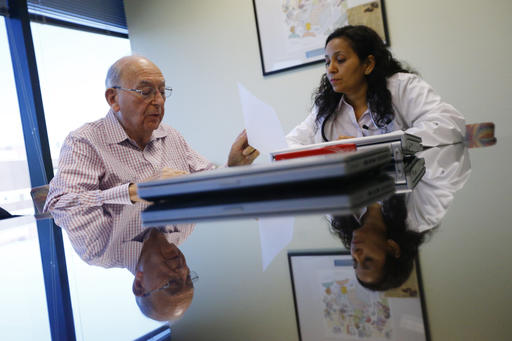
Some early results
End-of-life conversation (AP Photo/Julio Cortez)
Since the passage of California’s End of Life Option Act (EOLOA), I have been very interested in how health care organizations are handling the law. I had the chance to hear from one large medical group at this month’s meeting of the American Society for Bioethics and Humanities Annual Conference in Washington, D.C. and have been ruminating on their experience.
In brief, the law allows a physician to provide a lethal prescription to a patient within the last six months of his or her life who voluntarily requests the prescription and who can take the medication him or herself. The patient must make the request twice and wait 14 days between requests, and a second physician must attest to the patient’s dire prognosis and the voluntariness of the request. Similarly, the physicians’, pharmacist’s, or institution’s participation is voluntary: any individual practitioner can refuse to participate or a whole institution can choose not to offer this to their patients.
One organization at the conference was willing to share their experience with the new law and described a process that is similar to other health care organizations I have been hearing about throughout the state. This involves having a centralized intake process for all requests and a referral system to physicians who have previously agreed to participate.
I was struck by two things in their presentation. First, they noted mixed feelings among their physicians. As many as half had expressed uneasiness with the decision to offer this option within the organization, indicating that they would not participate in the process were they to be asked. This ambivalence was also reflected in the low number of physicians who had volunteered to participate, should a patient request it. At the time of the presentation only 10 percent had volunteered.
Another thing that struck me was the number of requests they had already received. The law went into effect in June of this year and already they’ve seen a very high number of requests, as many as 150 within their group.
While physician-assisted death is legal in four other states, California is by far the largest and most diverse in which it is legal. We know from Oregon’s experience with its Death With Dignity Act, passed in 1997, that the vast majority of people who make an initial request under the law do not go on to fill the prescription, and only about half of those who actually fill the prescription go on to ingest it. Many people requesting the medication report wanting a sense control over their disease and dying process and are satisfied knowing they could take the medication if they felt the need.
This seems to be holding true in California as well, as many of those who requested have not gone through the entire process. Nor does it seem to be true that the rate of request is any greater in California than in Oregon, where the percentage of individuals who chose to die this way in 2015 was about 39 individuals per 10,000 deaths.
But even a small percentage of a large population is a lot of people. The group presenting at the ASBH conference posited that California may have as many people who die under the EOLOA in one year as Oregon has had in the 18 years since the Death with Dignity Act was passed. In 2010 there were 233,143 deaths in California. If California has the same rate of EOLOA deaths as Oregon had DWDA deaths in 2015, California could see about 900 deaths from the EOLOA this year, which is, in fact, as many as Oregon has had total.
Of course, California has almost 10 times the population of Oregon. Also, 900 would represent less than 1 percent of all deaths, which is low when compared to rates in other countries with assisted death legislation, which tend to hover between 1 and 1.5 percent.
The truth is, it’s too early to predict the rate of EOLOA deaths in California. There are many reasons that the number of requests might have been high just after the law went into effect. But the numbers do make one sit up and take notice.
Ryan Holmes is the assistant director of health care ethics at the Markkula Center for Applied Ethics.